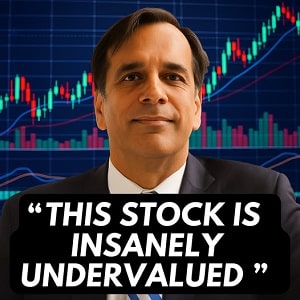As 2025 draws to a close, U.S. investors are facing a perfect storm of risks. Sky-high valuations in the technology sector, persistent hawkish signals from the Federal Reserve, and unpredictable tariff policies from the incoming Trump administration have created an environment of heightened uncertainty. Even Nvidia’s blockbuster Q3 earnings on Wednesday—widely expected to ignite another AI-fueled rally—only produced a brief overnight pop before a brutal Thursday sell-off wiped out those gains and pushed the Nasdaq into the red.
The S&P 500 remains within striking distance of all-time highs, but the cracks are showing. Forward earnings multiples for the “Magnificent Seven” now exceed 30x, concentration risk is at levels not seen since the dot-com era, and any meaningful rotation out of AI winners could trigger a sharp correction.
In this environment, many seasoned investors are looking beyond U.S. borders for high-quality, undervalued companies that offer both defensive characteristics and compelling upside. This year, international stocks—especially in North Asia and Southeast Asia—have quietly outperformed while flying under the radar of most American retail investors.
Below are the top 4 international stocks to buy as AI momentum weakens, each trading at deep discounts to intrinsic value, offering generous dividend yields, and backed by improving fundamentals and bullish technical setups.

Best 4 International Stocks to Buy Right Now as U.S. AI Momentum Shows Cracks
With the “Magnificent Seven” trading at 30–50× forward earnings, concentration risk at dot-com-bubble levels, and fresh volatility triggered by tariff uncertainty and Fed hawkishness, many professional investors are rotating capital into high-quality international names that remain dramatically undervalued. This year alone, markets in South Korea and Southeast Asia have delivered some of the strongest returns globally while still trading at single-digit P/E ratios and fractions of book value. The four stocks below combine bulletproof balance sheets, generous dividend yields of 3–7%, improving earnings trends, and bullish technical setups—making them ideal defensive yet high-upside alternatives as the U.S. AI trade finally rolls over.
1. Shinhan Financial Group Co., Ltd. (NYSE: SHG)
Country: South Korea
Sector: Financial Services
Market Cap: ~$25.5 billion
Forward P/E: 7.94x
Price-to-Book: 0.50x
Dividend Yield: ~3.2%
Shinhan Financial Group is one of South Korea’s “Big Four” banks and a true conglomerate offering retail banking, corporate lending, credit cards, insurance, asset management, securities brokerage, and private equity services. With over 13,000 employees and an extensive domestic branch network, Shinhan enjoys enormous pricing power and sticky customer deposits—classic traits of a high-quality financial franchise.
The bank reported robust Q3 2025 results earlier this month, with net interest income climbing year-over-year and net interest margins expanding for the third consecutive quarter. Loan growth remained healthy (mid-single digits), while credit costs stayed remarkably low—evidence of pristine underwriting standards even in a higher-rate environment.
Yet despite these strengths, SHG continues to suffer from the infamous “Korea Discount”—a decades-long phenomenon where South Korean equities trade at persistent discounts to global peers. The root causes have been poor capital allocation (conglomerate structures, cross-shareholdings, low dividend payouts) and perceived geopolitical risk.
Everything is changing in 2025.
The South Korean government launched the “Corporate Value-Up Program” in early 2025, pressuring listed companies to improve shareholder returns through higher dividends, share buybacks, and clearer governance. The results have been dramatic: the KOSPI index is up 68% year-to-date—one of the best-performing major indices globally—while foreign investors have poured in billions.
Shinhan has responded aggressively. Management raised its dividend payout ratio target and announced a new share repurchase program. The stock now yields north of 3% while trading at just 0.5x book value—an absurdly low valuation for a bank with double-digit return on equity potential.
From a technical perspective, SHG has broken out of a multi-year base and now trades comfortably above both its 50-day and 200-day simple moving averages. The 50-day SMA has acted as dynamic support on every pullback since June, and volume has expanded on up days—classic signs of institutional accumulation.
For investors worried about U.S. market concentration and elevated valuations, Shinhan offers the ultimate combination of safety, income, and upside as the Korea Discount finally begins to close.
2. POSCO Holdings Inc. (NYSE: PKX)
Country: South Korea
Sector: Materials / Battery Supply Chain
Market Cap: ~$16 billion
Forward P/E: 14x
Price-to-Book: 0.40x
Dividend Yield: ~3.3%
POSCO Holdings is best known as one of the world’s largest and most efficient steel producers, but the market is dramatically underpricing its pivot into the lithium and battery materials supply chain.
Steel remains a highly cyclical business, and President Trump’s campaign promises of 60% tariffs on imported steel have weighed on sentiment. However, POSCO has spent the last five years aggressively diversifying away from commodity steel margins into much higher-value segments.
The crown jewel is its lithium business. POSCO has already secured:
- A joint-venture lithium extraction plant in the United States (using direct lithium extraction technology)
- Mining rights and offtake agreements worth nearly $800 million in Australia and Argentina
- Downstream cathode and anode material plants in South Korea
These investments position POSCO as one of the few non-Chinese companies with integrated exposure to the entire lithium battery value chain—exactly the type of “friend-shoring” play that Western governments want to encourage.
Despite this transformation, the market still values POSCO as if it were a pure-play steel company. Shares trade at just 0.4x book value and 14x forward earnings—valuations more typical of distressed commodity producers than a company with growing exposure to the secular EV and energy storage boom.
Technically, PKX bottomed in February 2025 and has been forming a clean ascending triangle with higher lows and a clear support trendline. The stock reclaimed both its 50-day and 200-day SMAs in September, and the Relative Strength Index (RSI) has been making higher highs since March—strong evidence of building bullish momentum.
With a 3.3% dividend yield and significant net cash on the balance sheet, POSCO offers asymmetric upside as the market awakens to its battery materials pivot.

3. PLDT Inc. (NYSE: PHI)
Country: Philippines
Sector: Telecommunication Services
Market Cap: ~$6–7 billion
Forward P/E: 7.5x
Price-to-Sales: 1.2x
Dividend Yield: 7.1% (one of the highest in global telecom)
PLDT is the Philippines’ incumbent telecom provider and—together with Globe Telecom—forms a cozy duopoly controlling over 95% of the mobile and broadband market. High barriers to entry, massive spectrum holdings, and a fast-growing population of 115 million people give PLDT tremendous pricing power and predictable cash flows.
Beyond traditional telecom, PLDT owns Maya—the country’s leading digital payments platform (formerly PayMaya). Maya has evolved into a full-fledged digital bank offering savings accounts, crypto wallets, micro-lending, buy-now-pay-later, and remittances. With only ~5% of Filipinos holding traditional bank accounts but over 70% owning smartphones, Maya is positioned at the intersection of two massive trends: financial inclusion and digital payments.
The stock cratered in September 2025 after the government announced plans to allow a third mobile operator (potentially backed by Chinese capital). That sell-off now looks overdone. Historical attempts to break the duopoly have failed spectacularly, and even if a third player enters, it would take years and billions in capex to build a competitive network.
In the meantime, PLDT continues to generate enormous free cash flow, paying out one of the highest dividends in the entire global telecom universe—over 7% at current prices.
Technically, PHI has staged an impressive recovery since the September panic low. The stock reclaimed its 50-day and 200-day SMAs in a matter of weeks, and the MACD just generated a fresh bullish crossover—suggesting the 16% rally since October is only the beginning.
For income-focused investors seeking emerging-market exposure without excessive volatility, PLDT is one of the most attractive high-yield opportunities on the board.
4. United Microelectronics Corporation (NYSE: UMC)
Country: Taiwan
Sector: Semiconductors (Foundry)
Market Cap: ~$20 billion
Forward P/E: 14x
Price-to-Sales: 2.4x
Dividend Yield: 6.8%
While Nvidia, AMD, and Broadcom trade at nosebleed multiples, one of the world’s largest dedicated foundries—United Microelectronics (UMC)—continues to be ignored by the AI frenzy.
UMC is part of the “Big Three” pure-play foundries alongside Taiwan Semiconductor (TSMC) and China’s SMIC. While TSMC dominates cutting-edge nodes (3nm, 5nm), UMC specializes in mature and specialty process technologies (28nm and above) used in automotive, industrial, power management, and consumer electronics—segments that are far less exposed to the boom-and-bust AI training cycle.
Demand for these “mature node” chips remains extremely strong. The global chip shortage exposed how dependent the auto and industrial sectors are on older fabs, and new capacity takes 3–5 years to come online. UMC is sold out through 2026 in many of its specialty processes.
After three straight quarters of earnings misses during the 2023–2024 downturn, UMC stunned the market with its Q3 2025 report: EPS beat estimates by more than 60%, revenue surprised to the upside, and gross margins expanded to 29.8%. Management cited pricing power and 95%+ utilization rates across its 12-inch fabs.
Despite the turnaround, UMC still trades at just 14x forward earnings and yields nearly 7%—valuations that make it one of the cheapest ways to own semiconductor exposure outside of China.
The stock has been consolidating in a textbook descending wedge since mid-2024. Both moving averages are flattening, RSI is curling higher, and volume has contracted sharply—classic signs that a breakout is imminent. A move above $9.50 would confirm resolution to the upside and likely trigger a rapid re-rating.
Why International Stocks Are Outperforming as U.S. AI Momentum Fades
The four companies above share several common traits:
- Deep value valuations (single-digit to mid-teens P/E, fractions of book value)
- High dividend yields (3%–7%) providing downside protection
- Exposure to secular growth themes outside the overcrowded U.S. AI trade (lithium, digital banking, mature-node chips, Asian consumer recovery)
- Improving technicals (reclaimed moving averages, bullish momentum indicators)
- Beneficiaries of policy tailwinds (Korea’s Value-Up program, Philippines digitalization, global onshoring of battery materials)
While the U.S. market remains dominated by a handful of mega-cap technology names trading at 30–50x forward earnings, these international giants offer the rare combination of quality, value, and income that has become almost impossible to find domestically.

Final Thoughts: Defensive Positioning Doesn’t Have to Mean Low Returns
As AI momentum shows signs of cracking—evidenced by Nvidia’s inability to hold post-earnings gains—rotating into high-quality international stocks may be one of the smartest moves investors can make heading into 2026.
Shinhan Financial (SHG), POSCO Holdings (PKX), PLDT (PHI), and United Microelectronics (UMC) are not speculative bets on the next hot theme. They are profitable, cash-rich, dividend-paying industry leaders trading at valuations that embed almost no growth expectations—despite clear catalysts in place.
For investors who believe a U.S. market correction is increasingly likely, these four international stocks deserve serious consideration today.
FAQ: Top 4 International Stocks to Buy as AI Momentum Weakens
Why are international stocks suddenly attractive when U.S. stocks are near all-time highs?
U.S. mega-cap tech now trades at 30–50× forward earnings with extreme concentration risk, while high-quality companies in South Korea, Taiwan, and the Philippines trade at 7–14× earnings and 0.4–1.2× book value. Many also pay 3–7% dividend yields. This valuation gap is the widest in decades, and 2025 policy reforms (especially in Korea) are finally closing the chronic “discount” on these markets.
Is it safe to invest in South Korean stocks with geopolitical tensions around North Korea and China?
Yes. The “Korea Discount” has existed for 30+ years and already prices in geopolitical risk. The KOSPI is up 68% YTD in 2025 despite those concerns, driven by domestic corporate governance reform and massive foreign inflows. Both SHG and PKX have global businesses and significant non-Korean revenue.
Will Trump’s proposed 60% tariffs destroy POSCO Holdings (PKX) since it’s a steel company?
No. Steel is now less than half of POSCO’s future growth story. The company is rapidly becoming a major lithium and battery-materials supplier with plants and mines in the U.S., Australia, and Argentina—exactly the type of “friend-shored” supply chain the U.S. wants. Tariffs may actually help its U.S.-based lithium extraction project.
I heard a third telecom operator is entering the Philippines — isn’t PLDT (PHI) finished?
Every attempt to break the Philippine duopoly in the last 20 years has failed spectacularly due to spectrum scarcity and huge capex requirements. Even if a new player eventually enters, it will take 5–7 years and tens of billions to build a national network. Meanwhile, PLDT throws off cash and pays a 7%+ dividend.
Why is United Microelectronics (UMC) so cheap compared to TSMC and Nvidia?
UMC focuses on mature-node (28nm+) and specialty chips for autos, industrial, and power management — segments ignored by the AI hype cycle. These nodes are sold out globally through 2026–2027 and have much less competition than leading-edge nodes. The 6.8% dividend yield and 14× forward earnings reflect that market neglect, not fundamental weakness.
Are these stocks hedged against a stronger U.S. dollar?
SHG, PKX, PHI, and UMC all report in local currencies that have weakened vs. the USD in recent years. A continued strong dollar actually acts as a tailwind for U.S. investors because you buy more shares with each dollar and receive higher USD-converted dividends.
Do these companies pay dividends in U.S. dollars, and are the yields sustainable?
All four are NYSE-listed ADRs and pay dividends in USD. Current payout ratios range from 30–55% of earnings (very comfortable), and free-cash-flow coverage is strong across the board. Even in a recession scenario, these yields appear sustainable.
How liquid are these ADRs? Can I trade them like normal U.S. stocks?
Yes. Average daily dollar volume ranges from $25 million (PHI) to over $150 million (UMC). All trade with tight spreads during U.S. market hours and are held by major institutions and ETFs.
Should I worry about currency conversion fees or foreign taxes on the dividends?
Dividends from South Korea (SHG, PKX) and Taiwan (UMC) are subject to a 15–20% withholding tax that is usually creditable on your U.S. tax return. Philippine dividends (PHI) have 10–25% withholding depending on tax treaties. Most U.S. brokers automatically handle the paperwork.
If the U.S. market corrects 10–20%, could these international stocks still go down with it?
Short-term correlation is always possible, but their ultra-low valuations, high dividend yields, and completely different growth drivers (Korea Value-Up program, lithium pivot, digital banking in Philippines, mature-node chip shortage) give them strong relative strength. In every major U.S. correction since 2000, undervalued Asian ADRs have recovered faster and often hit new highs while the S&P 500 was still negative.
These four stocks offer the rare combination of deep value, high income, and multiple re-rating catalysts — exactly what defensive investors should own as the U.S. AI trade shows its first real cracks.
































